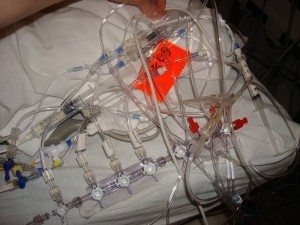 SAN JOSE, CA – The intensive care unit (ICU) at Holy Cross Hospital is ecstatic to receive an upcoming patient from the operating room who should have multiple lines and monitors to untangle.
SAN JOSE, CA – The intensive care unit (ICU) at Holy Cross Hospital is ecstatic to receive an upcoming patient from the operating room who should have multiple lines and monitors to untangle.
Very shortly the team will be receiving a multiple level spinal fusion patient who has 2 peripheral IVs, a central line, multiple drips without any labels, an arterial line, a Foley, JP drains, some leftover SSEP wires, and normal monitors.
Given that the patient was prone intraoperatively and will be rotated 180 degrees should ensure maximal line tangling. As an added bonus, it is reported that the ICU bed that the patient is arriving on has a broken steer mechanism and no IV pole.
If receiving this patient wasn’t exciting enough for the ICU nurses and respiratory therapists, that it may be happening right at change of shift is making the anticipation unbearable.
ICU nurse, Samantha Watkins, describes how her body has “pure adrenaline, like 70mcg/min” just thinking about untangling the lines. “It’s like a game for me. I dream about untangling knots, taking a half-ass report from the anesthesiologist, and dealing with immediate hypotension and tachycardia as they walk away.”
One of the off-going nurses chimed in, “Looks like there are no surgical orders in the computer. You will just have to guess what to do, or page the residents only 13 times.”
If it is CNA Janice’s lucky day, the Foley catheter bag will need to emptied almost immediately. “The nurses always give me that job and I love it! This is going to be great. I’m sure the gown and sheets will need to be changed, or at least I HOPE they do!”
“Can you imagine if the IV bag is empty!” nurse Watkins said as if she was welcoming the Beatles to America. “I’ll head to the Pyxis immediately. It will take about 5 minutes just to get one IV bag but it will be so worth it!” There was also hope that the medical chart was left behind in the OR.
The ICU team is so excited to take this patient that they hope report won’t be called, so that they can “be surprised” when the patient just shows up. “I equate it to not knowing the sex of your baby in-utero. I love the surprise of guessing when the patient will show up and what we will need,” says Watkins.







